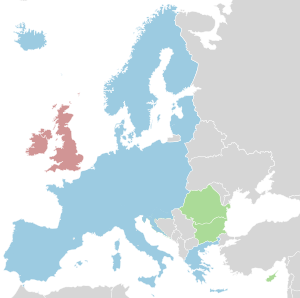 Image via WikipediaWHITE PAPER - Roadmap to a Single European Transport Area – Towards a competitive and resource efficient transport system (31 page pdf, European Commission, Mar. 28, 2011)
Image via WikipediaWHITE PAPER - Roadmap to a Single European Transport Area – Towards a competitive and resource efficient transport system (31 page pdf, European Commission, Mar. 28, 2011)Also discussed here: EU transport chief releases radical plan to cull petrolheads (Carlton Reid, BikeBiz, Mar. 29, 2011)
And here: EU to ban cars from cities by 2050 (The Telegraph, Mar. 30, 2011)
The focus today is on the recently released White Paper from the EU which outlines various steps to move toward a carbon free major cities within the next 20 years through the use of new technology, investments in infrastructure and relying on user/polluter pays to achieve greater mobility.
[youtube=http://www.youtube.com/watch?v=qHx5SL0ZrpU]
Transport White Paper presented in Brussels
(2.15 min You Tube video)
Key Quotes:
“The plan also envisages an end to cheap holiday flights from Britain to southern Europe with a target that over 50 per cent of all journeys above 186 miles should be by rail”
“"That means no more conventionally fuelled cars in our city centres..Action will follow, legislation, real action to change behaviour"
“people contaminating city centres with exhaust fumes and engine noise will get the same respect as dog owners not collecting their pets droppings or men urinating in public”
"Curbing mobility is not an option, neither is business as usual. We can break the transport system's dependence on oil without sacrificing its efficiency and compromising mobility. It can be win-win"
“Future development must rely on a number of strands:
- Improving the energy efficiency performance of vehicles across all modes. Developing and deploying sustainable fuels and propulsion systems;
- Optimising the performance of multimodal logistic chains, including by making greater use of inherently more resource-efficient modes, where other technological innovations may be insufficient (e.g. long distance freight);
- Using transport and infrastructure more efficiently through use of improved traffic management and information systems”
- Halve the use of ‘conventionally-fuelled’ cars in urban transport by 2030; phase them out in cities by 2050; achieve essentially CO2-free city logistics in major urban centres by 2030
- 30% of road freight over 300 km should shift to other modes such as rail or waterborne transport by 2030, and more than 50% by 2050, facilitated by efficient and green freight corridors.
- Move towards full application of “user pays” and “polluter pays” principles and private sector engagement to eliminate distortions, including harmful subsidies, generate revenues and ensure financing for future transport investments.
Related articles
- EU plan to phase out 'conventionally fueled' cars by 2050 (gizmag.com)
- white paper 2011 (ethempekin.com)
- The latest waste of time and money video from the European Commission (jonworth.eu)
- Europe: EU to ban cars from cities by 2050 (inautonews.com)
- European Commission outlines comprehensive Transport 2050 plan to increase mobility while cutting transport CO2 emissions 60%; phasing out conventionally-fueled cars in cities by 2050 (greencarcongress.com)
- European Commission Proposes to Push Gasoline- and Diesel-Powered Cars Out of Cities by 2050 (scientificamerican.com)
- Ban petrol cars by 2050, EU urges - BBC News (news.google.com)
- EU to ban cars from cities by 2050 (anationbeguiled.wordpress.com)
- EU to ban cars from cities by 2050 to force drivers to go 'green' (dailymail.co.uk)
- EU to ban cars from cities by 2050 (fellowshipofminds.wordpress.com)
- Forward Thinking - European Union Banning Gasoline-Powered Vehicles by 2050 (lockergnome.com)
- Cairns City Centre needs to ban cars -EU to ban cars from cities by 2050 - Telegraph (rajcairnsreport.wordpress.com)
- EU to ban cars from cities by 2050 (peregrine5700.wordpress.com)
- EU working on plans to ban gas and diesel by 2050 (americablog.com)

No comments:
Post a Comment